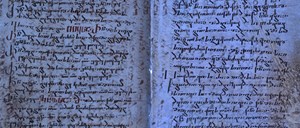
It is an important puzzle piece in the history of the Bible and one of the oldest witnesses to the Gospels: a small manuscript fragment of the Syrian translation from Greek, which was written in the 3rd century and copied in the 6th century. A researcher from the Austrian Academy of Sciences has now discovered the fragment with the help of ultraviolet photography in the Vatican Library.
It is an important puzzle piece in the history of the Bible and one of the oldest witnesses to the Gospels: a small manuscript fragment of the Syrian translation from Greek, which was written in the 3rd century and copied in the 6th century. A researcher from the Austrian Academy of Sciences has now discovered the fragment with the help of ultraviolet photography in the Vatican Library.
"The tradition of Syrian Christianity has several translations of the Old and New Testaments," says Grigory Kessel, a medievalist at the Austrian Academy of Sciences. "Until recently, only two manuscripts were known to contain the Old Syriac translation of the Gospels. While one of them is now held at the British Library in London, another was discovered as a palimpsest at the Monastery of St. Catherine on Mount Sinai. Recently, fragments from a third manuscript were identified as part of the 'Sinai Palimpsests Project.'"
The newly found small manuscript fragment can be considered the fourth witness to the text. With the help of ultraviolet photography, Grigory Kessel identified it as the third layer of text, a double palimpsest, in a manuscript at the Vatican Library. This fragment is the only known remnant of the fourth manuscript that attests to the Old Syriac version and provides a unique access point to the very early phase in the history of textual transmission of the Gospels.
The more translations that are known, the more the science learns about the original text of the Gospels. For example, while the Greek original of Matthew's Gospel, chapter 12, verse 1 reads, "At that time Jesus went through the grainfields on the Sabbath; His disciples were hungry and began to pick some heads of grain and eat them," the Syriac translation reads, "[...] they began to pick some heads of grain, rub them with their hands, and eat them."
Claudia Rapp, director of the Institute for Medieval Research at the Austrian Academy of Sciences, is also pleased with the discovery. "Thanks to his profound knowledge of ancient Syriac texts and script characteristics, Grigory Kessel has made a great find," she says. The Syriac translation, which dates back to the 3rd century, was written at least a century before the oldest surviving Greek manuscripts, including the important Codex Sinaiticus. The earliest surviving manuscripts with this Syriac translation date back to the 6th century and are preserved in palimpsests.
"This discovery demonstrates how productive and important the interplay of state-of-the-art digital techniques can be in basic research when encountering medieval manuscripts," says Claudia Rapp

ArtDependence Magazine is an international magazine covering all spheres of contemporary art, as well as modern and classical art.
ArtDependence features the latest art news, highlighting interviews with today’s most influential artists, galleries, curators, collectors, fair directors and individuals at the axis of the arts.
The magazine also covers series of articles and reviews on critical art events, new publications and other foremost happenings in the art world.
If you would like to submit events or editorial content to ArtDependence Magazine, please feel free to reach the magazine via the contact page.